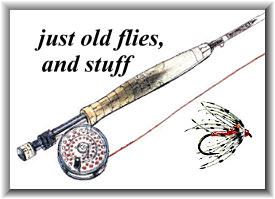
Welcome to 'just old flies,' a section of methods and flies that used-to-be. These flies were tied with the only materials available. Long before the advent of 'modern' tying materials, they were created and improved upon at a far slower pace than today's modern counterparts; limited by materials available and the tiers imagination.
Once long gone, there existed a 'fraternity' of anglers who felt an obligation to use only the 'standard' patterns of the day. We hope to bring a bit of nostalgia to these pages and to you. And sometimes what you find here will not always be about fishing. Perhaps you will enjoy them. Perhaps you will fish the flies. Perhaps?
FROM THE VICE OF THE MAYFIELD TYER
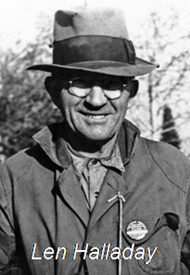 Leonard Halladay (1872-1952) created the Adams Fly in 1922 for Charles Francis Adams an attorney from Lorain, Ohio. His biography, and additional research, has revealed that he was never a judge. The title of judge was simply conferred to him by his friends and acquaintances. The story of the creation of the Adams is well documented by, Harold Smedley in his book, "Fly Patterns and Their Origins," and has been confirmed by the Halladay family.
Leonard Halladay (1872-1952) created the Adams Fly in 1922 for Charles Francis Adams an attorney from Lorain, Ohio. His biography, and additional research, has revealed that he was never a judge. The title of judge was simply conferred to him by his friends and acquaintances. The story of the creation of the Adams is well documented by, Harold Smedley in his book, "Fly Patterns and Their Origins," and has been confirmed by the Halladay family.
This article is a result of several years of research. Much of the information came from phone interviews and correspondence with Len Halladay's grandson, John Falk. In 2009, Mr. Falk produced a video entitled, "Grandpa's Story." In the video Mr. Falk provides the entire history of Leonard Halladay, the history of the Adams fly and the pattern information of many of the flies that his grandfather created. The video is archived at the Kingsley Branch Library in Kingsley, Michigan. The library also has a permanent display of Len Halladay memorabilia including several original patterns tied by him. Each year in June, the library hosts the "Adams Festival," which is well worth attending. The video is also available for viewing on 'YouTube.'
Sometime between 1902 and 1909, Len Halladay and his wife Mary Marillus (Koch) Halladay purchased The 'Kelly Boarding House' which was located on the banks of Mayfield Pond, in Mayfield, Michigan. They renamed it the 'Halladay Hotel'. With the logging industry fading, it was here that Len and Rilla made their living catering to hunters and fishermen from surrounding states. Rilla ran the hotel while Len provided year round services, guiding local sportsmen who wanted to hunt and fish the area.
As a fly tyer, Leonard Halladay was one of the simple old 'masters.' He always tied with 'Mustad' hooks. He used only black silk and cotton sewing thread, which he waxed himself. He raised Rhode Island Reds and Plymouth Rock chickens, which explains why his hackle choices were always either brown or grizzly. His threads were tied onto an old fishing reel to apply tension to the thread. He seldom tied smaller than a size #16. He used a lot of wool as a tying material. The tyers of the early part of the century were not concerned with details and often their flies were crudely tied … such was the case with Len Halladay. While examining many of his original flies I found that he never used more than one or two turns of hackle in front of the wings. All of his fly patterns were secured with a special knot which he called his 'buggy whip finishing knot.' This knot was jealously guarded and was only known to Len and his grandson. Len tied until his death in 1952, his creative years were from 1920 to about 1930.
Let's examine some of the great flies that came from his vice. The first fly is of course the Adams. The fly in the first photograph, was actually tied by Len Halladay himself. Ten years after its creation, George H. Wells, a professor at Ferris State University and a well-known sports writer of the 40s and 50s, went to Len Halladay and asked him to tie up an 'original' just as he had done for Mr. Adams some ten years earlier. Len obliged. This is one of the flies that appears in the display cabinet at the Kingsley Library.
Adams
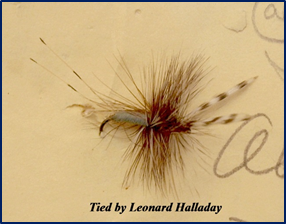
- Hook: Mustad Dry Fly Size: 10-16
- Thread: Black, 6/0
- Tail: Golden Pheasant Tippet, two strands
- Wings: Grizzly Hackle Tips, tied semi spent, advanced forward.
- Body: Gray Wool Yarn
- Hackle: Brown & Grizzly, mixed
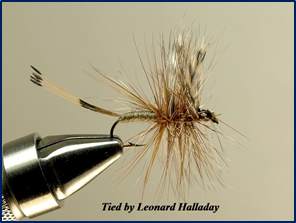 The unbroken succession from creator to the display makes this fly probably the only fully documented 'Adams' in existence. The wool used to tie the fly was 'Chadwicks Wool Mending Yarn,' Art E67, color #1525. The yarn was distributed by the, 'Spool Cotton Company,' from New York (1899-1950s). Please note that the hackle is tied almost completely behind the wings. This is a significant characteristic of Halladay's flies. Today's versions of this fly are usually tied with a synthetic body, upright and divided wings, and the hackle tied in with a modern day formulary.
The unbroken succession from creator to the display makes this fly probably the only fully documented 'Adams' in existence. The wool used to tie the fly was 'Chadwicks Wool Mending Yarn,' Art E67, color #1525. The yarn was distributed by the, 'Spool Cotton Company,' from New York (1899-1950s). Please note that the hackle is tied almost completely behind the wings. This is a significant characteristic of Halladay's flies. Today's versions of this fly are usually tied with a synthetic body, upright and divided wings, and the hackle tied in with a modern day formulary.
Here is a second photograph of another original Adams fly, please note there are several differences. Shortly after its creation Leonard Halladay began to 'tweak' his own pattern. The tail, made of Golden Pheasant Tippet, now consisted of a small clump of fibers; anywhere from two to five. The wings have now been pulled back to a vertical position. I have examined several original patterns; the wings are tied anywhere from upright and divided to semi-spent. We do not know if this was arbitrary on the part of the tyer or at the customer's request. Please note the crudely tied hackle and the poorly tied head … also quite typical of Len Halladay and other tyers of the times.
Hair Stone
 Hook: Mustad Dry Fly Size: 8-12
Hook: Mustad Dry Fly Size: 8-12- Thread: Black, 6/0
- Tail: Pig Bristles, 2 or 3, dyed red
- Wings: Deer Hair, tied spent
- Body: Gray Wool Yarn
- Rib: Yellow Monocord, 3/0
- Hackle: Brown & Grizzly, mixed, 2 brown an one grizzly.
I actually compared a swatch of the original mending wool used on the Adams to the wool used on this pattern. I am convinced that the samples are the same. According to the family this was Len's personal favorite. He liked fishing with this fly, above all others. Again note that the hackle is tied behind the wings and also note that as before, the fly was crudely tied. These roughly tied flies present a very 'buggy' appearance; this may be part of the mystique that made his flies so effective. When Len was asked, "Why the red tail?" He responded, "Sometimes a tyer must add something distinctive in order to sell the fisherman as well as the fish."
Michigamme
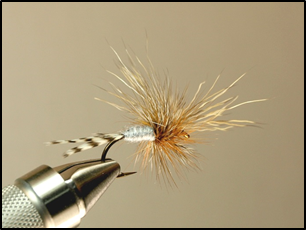
- Hook: Mustad Dry Fly Size: 8-14
- Thread: Black, 6/0
- Tail: Grizzly Hackle Tips, two
- Wings: Natural Deer Hair, tied spent
- Body: Gray Wool
- Hackle: Brown & Grizzly mixed, 2 brown and one grizzly
Nothing is known about the specifics of how the Michigamme got its name. In the Upper Peninsula of Michigan there is a small town and a lake named Michigamme. It most probably was named in honor of another of Len's regular customers. It would be logical to assume that Mr. Halladay used the same gray wool on the Michigamme as he did on the Hair Stone and the Adams.
I chose these three flies of Leonard Halladay to present first so that I might draw a comparison about their similarities. The three flies are analogous to each other; each with a gray body and a brown and grizzly hackle. The Adams was created in 1922. What of the other two? Did Len create the Adams from scratch or did he modify one of his already existing patterns? The other possible scenario is that the Adams was created first and the other two patterns were variations that he created later. No dates on the Hair Stone and Michigamme have been provided.
Dr. Kirgin
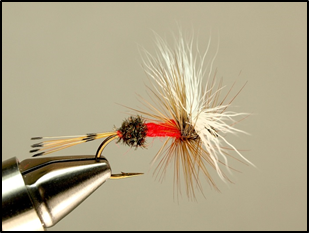
- Hook: Mustad Dry Fly Size: 10-16
- Thread: Black, 6/0
- Tail: Golden Pheasant Tippets, small clump of 4-5
- Body: Peacock Herl, rear 1/4 of the hook, red yarn forward
- Wing: White Bucktail, divided, tied spent
- Hackle: Brown, one hackle
This fly was obviously patterned after the original Royal Coachman (wet fly) created by John Haily of New York, in 1878. I say that because the dry fly version with hair wings did not appear until 1929. Although we do not have an exact date, Len's grandson insists that Len was tying this fly, "long before 1929." If this is so, that would make this fly one of the very first hair wing dry flies ever created. Len also tied this fly with, "Chadwicks Wool Mending Yarn," E67. We do not however have a color number. The fly was named after Len's physician friend from Ohio by the name of Dr. Kirgin. Reportedly Len and Dr. Kirgin often fished the Boardman River together.
Halladays's Hopper
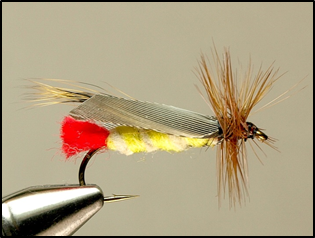
- Hook: Mustad Dry Fly Size: 8XL
- Thread: Black, 6/0
- Tail: Tuft of Red Yarn
- Underbody: Red Yarn
- Overbody: Kapok
- Rib: Yellow Yarn
- Underwing: Fox Squirrel
- Overwing: Mallard Duck Quill
- Hackle: Brown Hackle, one
Hopper patterns were rare during the 20s and 30s, so this should be considered one of the first hopper patterns developed in Michigan. Until World War II, many of the old tyers used natural kapok to make their flies float better. During the war the government appropriated all available kapok to be used for life vests. Most of the old patterns utilizing kapok have been lost to antiquity. This pattern survived. It would be safe to assume that the rib was tied with "Chadwicks Wool Mending Yarn."
Caddis Fly
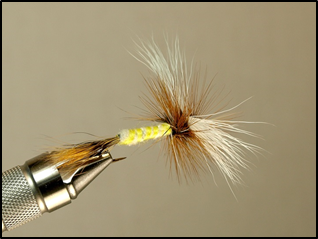 Hook: Mustad Dry Fly Size: 6XL
Hook: Mustad Dry Fly Size: 6XL- Thread: Black, 6/0
- Tail: Fox Squirrel, tied bushy
- Wing: White Deer Hair, tied spent
- Body: Natural Kapok
- Rib: Yellow Yarn
- Hackle: Brown, two hackles
This pattern was created for Michigan's famous Hexagenia limbata hatch, misnomered the caddis hatch. This insect hatch is so famous in Michigan that fishermen travel from around the world to fish the event. Len Halladay would send out post cards to his regular customers to inform them of the arrival of the hatch. This is another kapok recipe that survived extinction. This fly is also called, "Halladay's Michigan Caddis."
Hex Fly
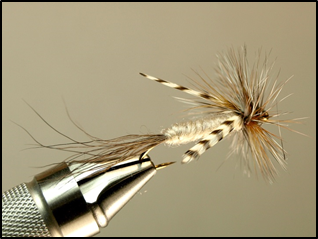
- Hook: Mustad Dry Fly Size: 8XL
- Thread: Black, 6/0
- Tail: Moose Body Hair, small clump
- Body: Tan Wool Yarn
- Wings: Grizzly Hackle Tips, tied spent, delta style
- Hackle: Brown & Grizzly, mixed, one each
In the display case at the Adams exhibit in Kinglsey, Michigan is personal memorabilia
and actual flies created by Leonard Halladay. This is one of the patterns on display. Len's grandson provided no tying information on this pattern so it was necessary to reverse engineer the fly by examining it using hand magnifiers in poor lighting conditions through a glass showcase. The recipe above may not be exact … but under the circumstances, it's the best I could do. The pattern is presumably an additional pattern created by Len for the Hexagenia limbata hatch. The body material, once again appears to be wool. The hackle on this fly takes one or two turns behind the wing with the bulk of the hackle tied in front of the wing.
Widdicomb
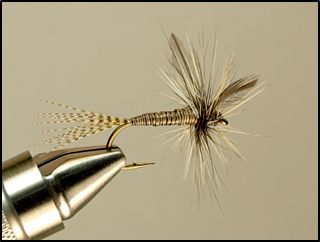
- Hook: Mustad Dry Fly Size: 12-14
- Thread: Black, 6/0
- Tail: Wood Duck Flank Fibers
- Body: Stripped Peacock Quill
- Wing: Light Dun Hackle Tips, tied spent
- Hackle: Golden Badger, tied light
No article on Halladay's flies would be complete without a mention of the Widdicomb. Ralph Widdicomb (1873-1959) was a furniture magnate from Grand Rapids, Michigan. He was a highly respected and experienced fisherman who spent most of his fishing time on the Pere Marquette, the Baldwin, and Little Manistee Rivers. According to the Halladay family lore, Ralph taught Len Halladay how to tie flies in 1917. This fly was conceived by Ralph Widdicomb. Len reportedly tied the first fly from Widdicomb's description. This fly was on the water sometime between 1917 and 1920.
Leonard Halladay, reputedly a simple and honest man who was trying to eke out a living for his wife and children during the early part of the century produced some truly incredible flies. We hear tell that he may have created the 'Female Adams.' We also hear that Leonard, years later, tied the Adams in both red and yellow bodies. There is no evidence to support or deny these claims. What we do know is that Leonard Halladay created one of the most famous and enduring flies of all times … the Adams.
See you on the water…..
 Tom is a retired biology instructor who hails from Westland, Michigan. He has over 30 years' experience on the water and at the bench. Tom is a historian of old Michigan dry flies and their creators. His flies, tying tips and articles have appeared in such publications as American Angler, Fly Tyer, Flyfishing & Tying Journal, Trout Fisherman and Cedar Sweeper.
Tom is a retired biology instructor who hails from Westland, Michigan. He has over 30 years' experience on the water and at the bench. Tom is a historian of old Michigan dry flies and their creators. His flies, tying tips and articles have appeared in such publications as American Angler, Fly Tyer, Flyfishing & Tying Journal, Trout Fisherman and Cedar Sweeper.
~www.michigandryflies.net~
Copyright2014@Deschaine
[ HOME ]
[ Search ] [ Contact FAOL ] [ Media Kit ]